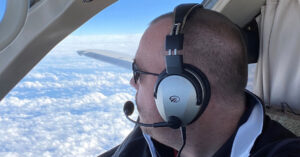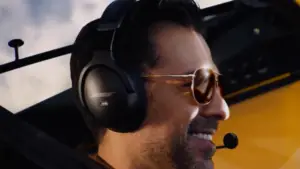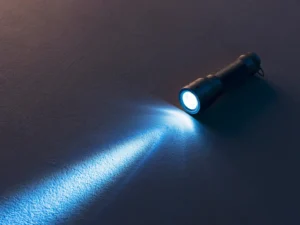What flashlights do pilots use?

Picture this: you’re at lunch with pilot friends, some of whom have been navigating the skies for decades. Amidst the chatter, a topic catches your attention – flashlights.
To outsiders, it might seem trivial, but in aviation, these are not just tools; they’re lifelines. As each pilot shares their story, you realize that a flashlight is more than a beacon of light; it symbolizes safety and expertise.
This article sheds light on the crucial role flashlights play for pilots beyond just illumination.
Did you know the first portable flashlight came into existence in 1899? Since then, it has become indispensable to a pilot’s gear, guiding them through the vast and often unpredictable skies.
The Necessity of Flashlights in Aviation
Cruising at altitude, the cockpit’s ambience can change instantly, with unforeseen circumstances often necessitating the swift use of a flashlight.
In emergencies, such as electrical failures or unexpected weather changes, a pilot’s flashlight becomes more than a tool; it transforms into a lifeline, guiding through instrument checks and critical decisions.
During pre-flight checks, its beam scrutinizes the aircraft’s exterior, seeking out potential hazards unseen in the darkness. The best flashlight’s role extends into communication, where its flickering light can convey vital visual signals, a language aviators understand worldwide.
In the cockpit, the smell of leather and the soft hum of instruments are often accompanied by the subtle click of a flashlight being switched on, ready to illuminate the path ahead.
Diverse Flashlight Options for Pilots
Pilots have many choices to suit their needs, from the bulkier, rugged handheld tactical flashlights to the sleek, efficient, compact utility lights. Handheld models offer a reassuring heft and brightness, ideal for thorough inspections and emergencies.
Their beam, slicing through darkness, can reveal the most minor anomaly on an aircraft’s surface. Meanwhile, helmet-mounted lights offer an unparalleled hands-free experience, vital for multitasking during complex flight operations.
Light dances across control panels, enabling pilots to keep both hands on the controls while navigating the night. In the confined cockpit space, where every inch and ounce matters, compact utility lights shine as the epitome of efficiency, easily tucked away yet powerful enough to light up the necessary spaces.
Essential Attributes
Durability is paramount, as these tools often endure the rigours of flight, from rapid altitude changes to the jostling of turbulent air.
Adjustable brightness is not just a feature but a necessity, allowing pilots to preserve night vision while providing ample illumination when required. Energy efficiency takes centre stage, with long battery life crucial during extended flights or unforeseen delays.
The light’s colour and intensity are carefully chosen to prevent glare, ensuring that a pilot’s vision remains unimpeded. This is essential for maintaining situational awareness in the cockpit’s dimly lit environment.
Selecting the Ideal Flashlight
Choosing a suitable flashlight for aviation use is a decision that intertwines functionality with personal preference.
The size and layout of an aircraft’s cockpit play a significant role in this choice; a more miniature, compact flashlight might be preferable in tight spaces, while a larger cockpit might allow for a more substantial light.
Personal preference in grip, weight, and usability is equally important, as comfort can significantly impact a pilot’s efficiency. Compliance with aviation regulations and safety standards is not just a formality; it’s a commitment to safety and professionalism.
Pilots often recall the first time they selected their flashlight, when they weighed these factors carefully, knowing that this small tool could one day be their guiding light in the skies.
Highlighting Renowned Flashlight Brands in Aviation
Brands like SureFire, Maglite, and Streamlight have become household names among pilots. SureFire is renowned for its high-intensity, durable flashlights, often the go-to choice for military aviators seeking reliability in the most demanding conditions.
On the other hand, Maglite is celebrated for its adjustable focus feature and robust design, making it a favourite among commercial pilots for its versatility. Streamlight stands out for its innovative designs, offering compact yet powerful lighting solutions ideal for the cramped cockpits of smaller aircraft.
The unique aspects of these brands – from the powerful lumens of a SureFire to the energy efficiency of a Streamlight – cater to the varied needs of pilots. For aviators, choosing a brand often goes beyond mere preference; it’s a decision that reflects their approach to safety, efficiency, and professionalism in the skies.
Innovations and Future Trends
Emerging technologies in flashlight design are integrating intelligent features, from programmable settings to adaptive light beams that respond to environmental changes.
These advancements promise to enhance a pilot’s experience, offering greater control and customization of their lighting tools. The future of pilot flashlights may even see the integration of augmented reality, projecting crucial flight information directly into the pilot’s line of sight.
The scent of innovation is in the air as developers and aviators eagerly anticipate the next breakthrough in flashlight technology that will once again redefine the boundaries of night flying.
What flashlights do pilots use Conclusion
The flashlight, though small in size, plays a monumental role in the life of a pilot. From the strategic selection of the ideal model to its meticulous maintenance, every aspect of a flashlight’s journey reflects the pilot’s dedication to safety and precision.
Much like the beam of a well-chosen flashlight, this article aims to illuminate the importance of this tool, guiding pilots and aviation enthusiasts alike in understanding and appreciating its value.
The echo of a flashlight’s click, the feel of its grip, the sight of its beam cutting through the darkness – these are more than mere sensory experiences; they are the subtle







